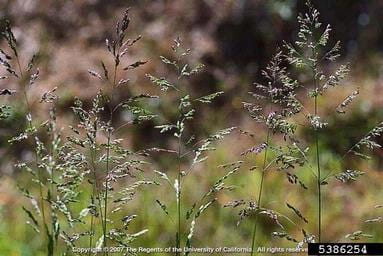Scientific name: Poa trivialis
Other names: rough-sheathed bluegrass, rough bluegrass
Roughstalk bluegrass (Poa trivialis) is a cool-season perennial that is a common problem in NYS for field crops, such as alfalfa and winter grains, as well as other disturbed areas. It favors half-shade and grows well in poor drainage, compact, and moist soil conditions.
Identification
Seedlings: The leaf bud is folded.
Mature plant: The sheath also has tiny rough hairs, and as a result is rough to touch. The root system produces stolons, and also spreads by seeds.
Height: 1-3 ft (0.3-0.9 m)
Similar species
Table 10: Shows roughstalk bluegrass (Poa trivialis) similarities and differences in identification compared to its similar species: colonial bentgrass (Agrostis tenuis), creeping bentgrass (Agrostis stolonifera), annual bluegrass (Poa annua), and Kentucky bluegrass (Poa pratensis).
| Species | Roughstalk bluegrass (Poa trivialis) | Annual bluegrass (Poa annua) | Kentucky bluegrass (Poa pratensis) | Colonial bent grass (Agrostis tenuis) | Creeping bent grass (Agrostis stolonoifera) | ||
|---|---|---|---|---|---|---|---|
| Similarities | Leaf bud folded | Closely related; leaf bud folded | Closely related; leaf bud folded | Similar to roughstalk bluegrass; produces stolons | Similar to roughstalk bluegrass; produces stolons | ||
| Differences | Height: 12 in to 3.3 ft (30 cm to 1 m); leaf bud rolled; has fibrous roots and produces stolons | Much smaller, grows up to a max of 12 in (30 cm); lacks stolons and shallow fibrous roots | Lighter in color; lacks stolons; produces rhizomes | Leaf bud rolled | Leaf bud rolled |
Management
Chemical
When planted in the fall or in winter wheat systems, mesosulfuron-methyl and thiencarbazone-methyl (such as Osprey Xtra) can be used to control the spread of roughstalk bluegrass.
Use CCE Eastern NY Horticulture’s tool to look up the efficacy of herbicides on bluegrasses (Poa spp.). For general guidance on weed control, get the latest edition of the Cornell Crop and Pest Management Guidelines.
Non-chemical control
Cultural: Early scouting in April can help identify if P. trivialis is going to be a problem. Manual removal is a possible method where small populations occur. P. trivialis also prefers shady damp areas. Therefore, a decrease in irrigation can help reduce the population.
Herbicide resistance
Reported as of 2021:
North America
None
Other continents
Europe
Group 2 (France)
For a more detailed report, please visit the reference section below or visit the International Herbicide-Resistant Weed Database homepage for more information on resistance.
References
Uva R H, Neal J C, DiTomaso J M. 1997. Weeds of the Northeast. Book published by Cornell University, Ithaca NY. The go-to for weed ID in the Northeast; look for a new edition sometime in 2019.
NC State Extension has a profile on roughstalk bluegrass, which discusses its biology and management.
Purdue University’s Turfgrass Science has a weed ID profile on roughstalk bluegrass that focuses on Turfgrass systems.
Ohio State University Extension has a page specifically on roughstalk bluegrass in cereal grain and forage crops.
University of Missouri has a Weed ID Guide on roughstalk bluegrass.
For New York State Roughstalk Bluegrass distribution and common names, check out New York Flora Atlas site.
University of Maryland Extension has more identification and control tactics for roughstalk bluegrass.
For general guidance on weed control, get the latest edition of the Cornell Crop and Pest Management Guidelines. Since Roughstalk Bluegrass is specifically problematic in alfalfa and winter grains you may be interested in the Field Crop Guidelines.
Herbicide resistance details
North America
None
Other continents
Europe
France, group 2 (iodosulfuron-methyl-Na, and mesosulfuron-methyl)

